Dazzled by the empire’s stately ruins and the Vatican’s artistic treasures, many visitors to the Eternal City are unaware of the many unique and outstanding Roman dishes that await.
But of course, it’s this bubbling cauldron of history that has helped slow-cook the flavors and shape of the capital’s cuisine. Of course, you’ll find favorites like pizza and pasta, but Roman food also includes cuisine that speaks directly, in carciofa di giudia, and more subtly, via gnocchi alla romana to the city’s past.
So when you’re torn between whether to first answer your hunger pangs or witness the majesty of Trajan’s Column, remember that the food you’re eating in Rome is also a cultural event.
Carbonara

Carbonara
The highest profile member of Rome’s legendary quartet of pasta dishes, carbonara is a creamy bowlful featuring either tubular rigatoni or stringy spaghetti.
Otherwise, it’s a hard and fast formula for the sauce; carbonara is a deftly blended mix of sharp pecorino romano cheese, an egg, and a splash of the starchy water that you cooked the pasta in.
And absolutely no cream. Or bacon, in fact, as is so often used in Western interpretations of this Italian dish. Instead, when in Italy, savor the rich flavor of guanciale instead. These thick salty slivers of cured pork jowl, contrasting beautifully with the glossy, flavorful sauce, will serve to light up your Roman night out.
Cacio e Pepe
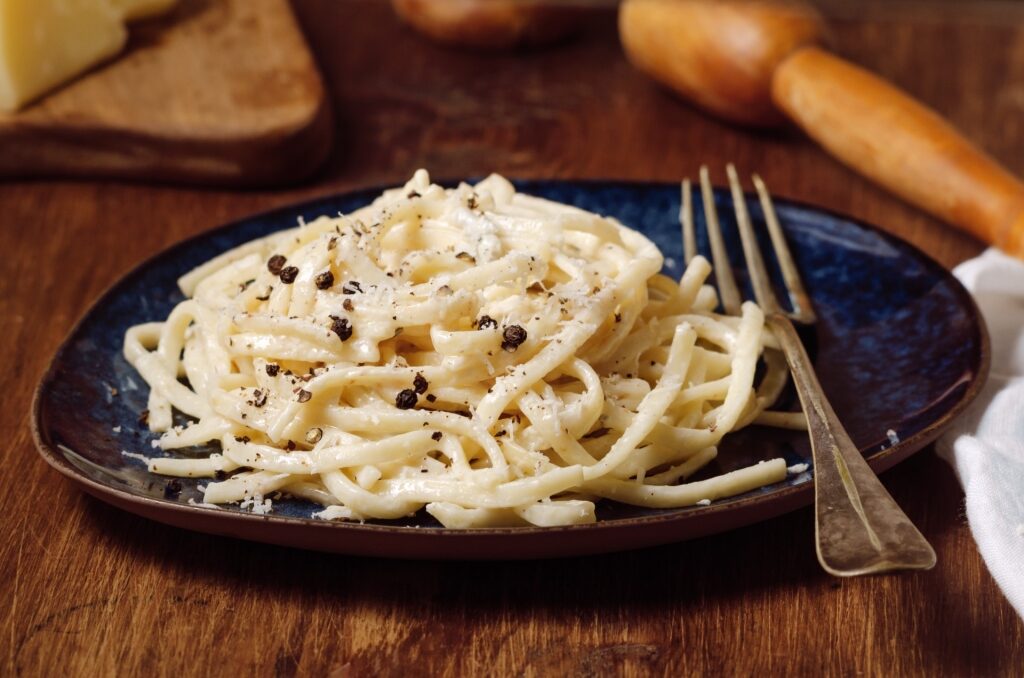
Cacio e pepe
Previously overlooked for the culinary stardom enjoyed by its cousin carbonara, cacio e pepe is something of an on-trend dish. Deceptively simple and yet entirely fulfilling, this pasta primi is another of Rome’s fantastici quattro.
A late-night, throw-it-together student favorite, cacio e pepe—as the name “cheese and pepper” suggests—requires only a handful of pantry-friendly ingredients. These are the omnipresent pecorino romano, pasta—tonnarelli or the hollowed-out bucatini is most often used—and two teaspoons of freshly cracked pepper.
The secret ingredient in this dish is starchy pasta water. It’s blended with the cheese to create a creamy, slippery sauce that coats the noodles. Head to the austere, revered Felice e Testaccio for one of the city’s best examples.
Gricia

Gricia
Pasta alla Gricia is the base from which Amatriciana, another of the quartet of Roman pasta dishes, derives.
Named for its believed town of origin, Grisciano, pasta alla Gricia began life as a dish for hardworking shepherds. With an ever-ready supply of good quality sheep’s cheese, these shepherding geniuses created a simple but dynamite mix of pecorino romano, guanciale which is cured pork jowl, and rigatoni.
It’s often known as “white amatriciana”, as all you need to transform this pale classic into that ruddy-hued classic is the addition of plum tomatoes to the sauce. You can find good bowlfuls of Gricia throughout the city, but the rigatoni at Da Enzo al 29, Trastevere, is highly regarded.
Amatriciana

Amatriciana
Amatriciana takes the bones of pasta alla Gricia and adds tomatoes. This delicious innovation occurred in the 18th century, and ever since that culinary eureka moment, the legions of amatriciana lovers have continued to swell.
In Rome, this warming, hearty dish of cured pork cheek, pecorino, and flavorful Italian tomatoes is best enjoyed close to the timeless Pantheon, at a seat in Armando al Pantheon.
Making this dish even more irresistible is the addition of peperoncino, which gives it an essential chili kick amid the rich, meaty sauciness. Despite its inclusion in the pantheon of great Roman pasta dishes, its origins, as the name suggests, are linked to the town of Amatrice, located at the eastern edge of Rome’s Lazio region.
Read: 3 Days in Rome
Abbacchio Scottadito
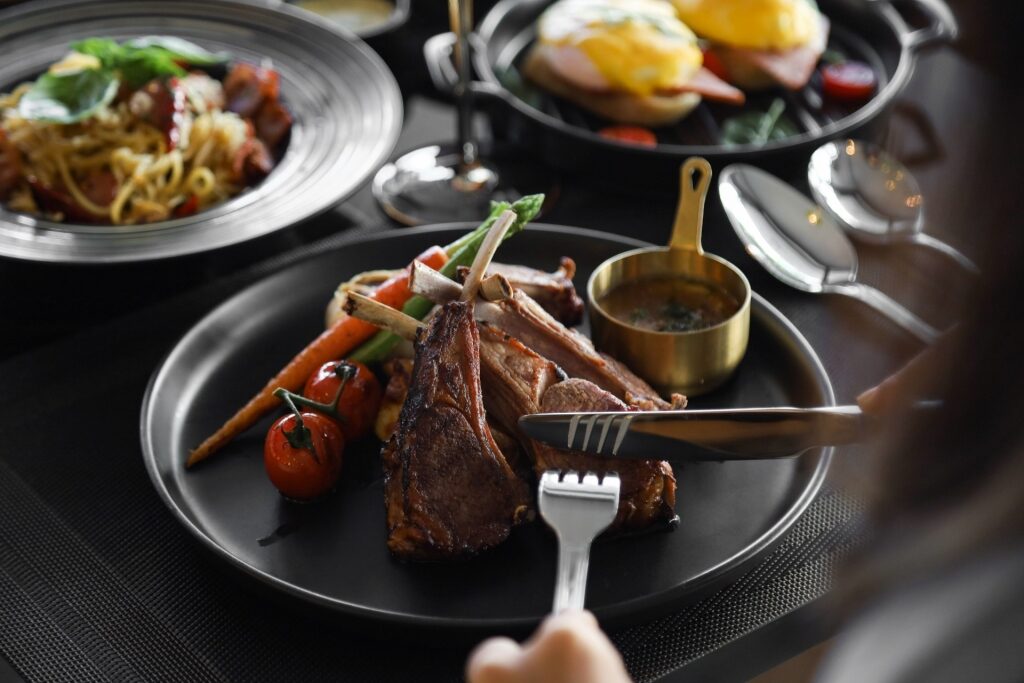
Abbacchio scottadito
Abbacchio Scottadito is a traditional Roman dish of grilled lamb chops. It’s a classic “secondi” or main course after you’ve already polished off a cacio e pepe for your “primi”, or first course.
For those boning up on advanced conversational Italian, you’ll probably have already translated “scottadito” as “burnt fingers”. It’s a hint that these simply made, seared chops are so delicious that you’ll end up with scorched digits trying to pluck them directly from the cooking surface.
Think of them as the lamb chop equivalent of bistecca alla Fiorentina. They’re simply flavored with a garlic and rosemary olive oil marinade before being seared on the grill and left with a juicy pink interior.
Gnocchi alla Romana

Gnocchi alla romana
While potato-based gnocchi is the variety most commonly encountered in our supermarkets and delis today, these creamy nuggets have a much broader scope for ingredients than one might at first think.
In the time when togas were on trend, gnocchi used to be made from a mixture of semolina and water. The arrival of potatoes from the New World made things a little more homogenous, although you’ll find that almost every Italian region has its riff on this pillowy crowd-pleaser. In Lombardy, they’re thrown together from milk, bread, and almond pieces.
Gnocchi alla Romana harkens back to the days of the Caesars. The dough is built from semolina, eggs, milk, and a fragrant pinch of nutmeg before being shaped with a cookie cutter. Laid attractively in a baking dish, it’s tucked in beneath a blizzard of parmigiano reggiano. A hearty favorite for when the city nights begin to draw in.
Saltimbocca alla Romana

Saltimbocca alla Romana
Saltimbocca alla Romana involves a juicy cut of veal, chicken, or pork pounded flat and wrapped in a wafer-thin slice of prosciutto. A sage leaf is impressed on the cured ham, and the meaty parcel is fried in a mix of sweet Sicilian marsala and butter. The prosciutto crisps up deliciously, as does the sage.
Despite the “Romana” part of the name, this dish is reportedly from the town of Brescia, about a five-and-a-half-hour drive north into the Lombardy region. It’s believed that the recipe, like so many of these deliciously simple dishes, may have been brought to the Romans’ attention via a traveling shepherd.

Saltimbocca alla Romana
The Romans tasted it, loved it, named it. And ever since, it’s been associated with the capital. Meanwhile “saltimbocca” translates as “jump in the mouth”, indicating how quickly people tend to finish this classic from the Cucina Romana.
It’s hard for this dish to go far wrong, but Trattoria da Teo in Trastevere is widely considered a safe pair of hands.
Supplì
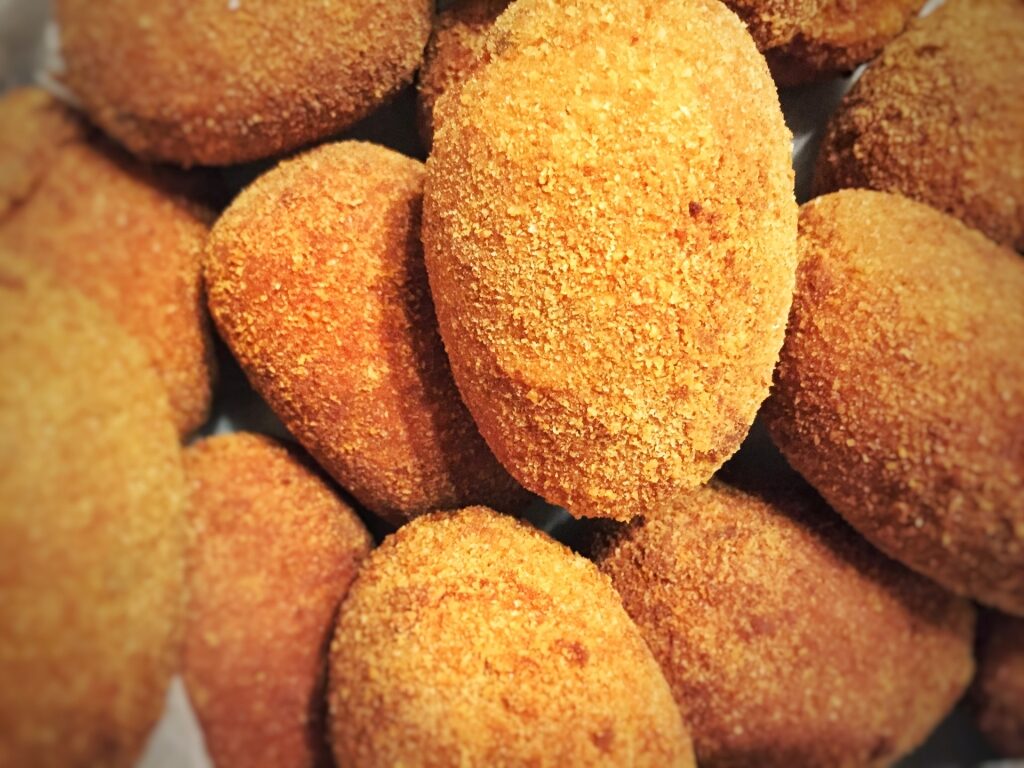
Supplì
Commonly found ornamenting plates of Roman antipasti, supplì are sausage-shaped, half-sized versions of Sicilian arancini.
It’s more than just the shape that distinguishes this more-ish treat from the breadcrumbed, baseball-sized creation hailing from the other side of the Tyrrhenian. The ingredients for supplì indicate how this Roman food is intended as an appetizer, rather than a filling snack like meaty arancini.
Supplì is formed from creamy grains of arborio rice infused with a rich tomato sauce. In the center of these breadcrumb croquettes, a blob of delicious mozzarella awaits discovery. This is the “surprise” that the name “supplì” hints at.
A more traditional version includes an entirely different kind of surprise involving chicken giblets. Head to Pizzarium at lunchtime, close to the Vatican, for crunchy, freshly made supplì.
Read: Best Things to Do in Rome With Kids
Porchetta

Porchetta
Porchetta is one of those Roman dishes that returns to mind again and again after you leave the city.
It’s not the only reason people feel a burning need to return to Rome after their last visit, but it’s definitely a contributing factor. Porchetta is a wonderfully seasoned, slow-roasted piece of pork belly or loin infused with rosemary and garlic.
It makes for a memorable mouthful, whether at a sit-down restaurant, on the go, or at the annual Sagra della Porchetta in nearby Ariccia, the home of porchetta.

Porchetta panini
You’ll find generously stuffed porchetta panini available at hole-in-the-walls throughout the capital. The juicy, tender meat is also scattered liberally across the pale discs of pizza bianca, where the crisp fat and pork pair deliciously with the mascarpone base.
Try it in a sandwich from the renowned Norcineria Lacozzilli deli, and a pizza bianca at Panificio Bonci on via Trionfale.
Coda Alla Vaccinara
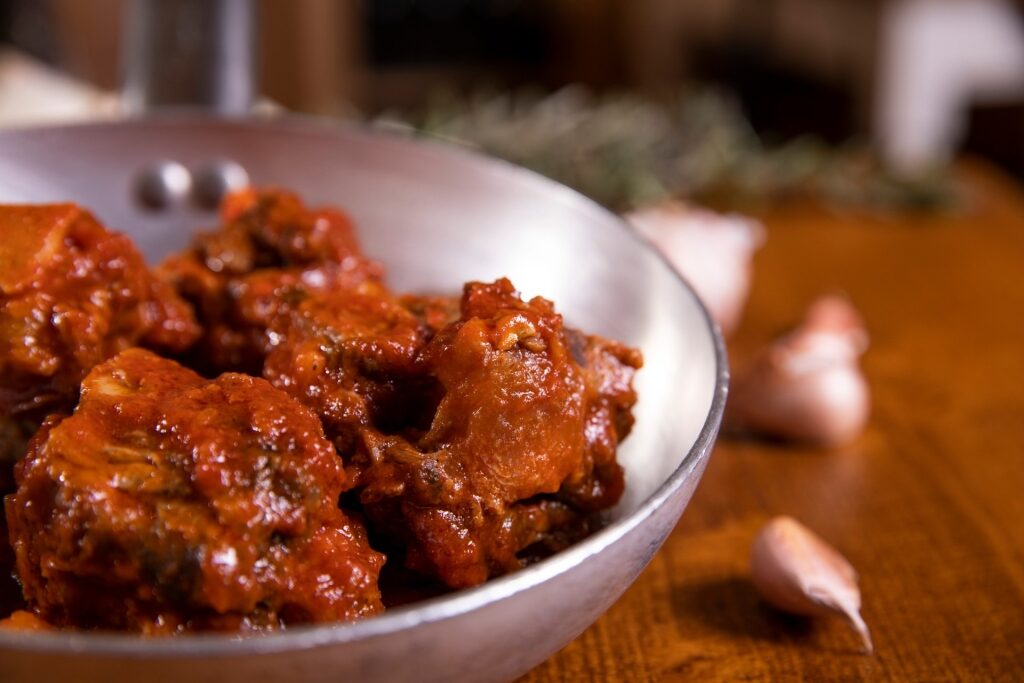
Coda alla vaccinara
Rione Regola, found on the left bank of the steel-blue Tiber, is one of Rome’s oldest neighborhoods. It’s a wonderful area to explore, with impressive palazzi and medieval churches lodged cheek by jowl into a small area of the city.
Coda alla vaccinara is an iconic dish from the Rione Regola. A traditional oxtail stew, its connection to the neighborhood was so strong that locals were nicknamed “mangiacode” or “tail-eaters”.
This dish belongs to a category of Roman dishes known as the “Quinto Quarto”—a category of dishes that involved parts of the animal that typically weren’t claimed by the upper echelons of Roman society. It’s pure working-class fare.
Embrace the epithet while visiting the area. Coda alla Vaccinara is a hearty sweet and sour stew involving pancetta, raisin and pine nuts. Its rich juices—imbued with red wine, nutmeg, and cinnamon—soak into a bed of polenta. It’s probably not high summer food, but any other time of the year is good for becoming a mangiacoda.
Carciofi alla Giudia
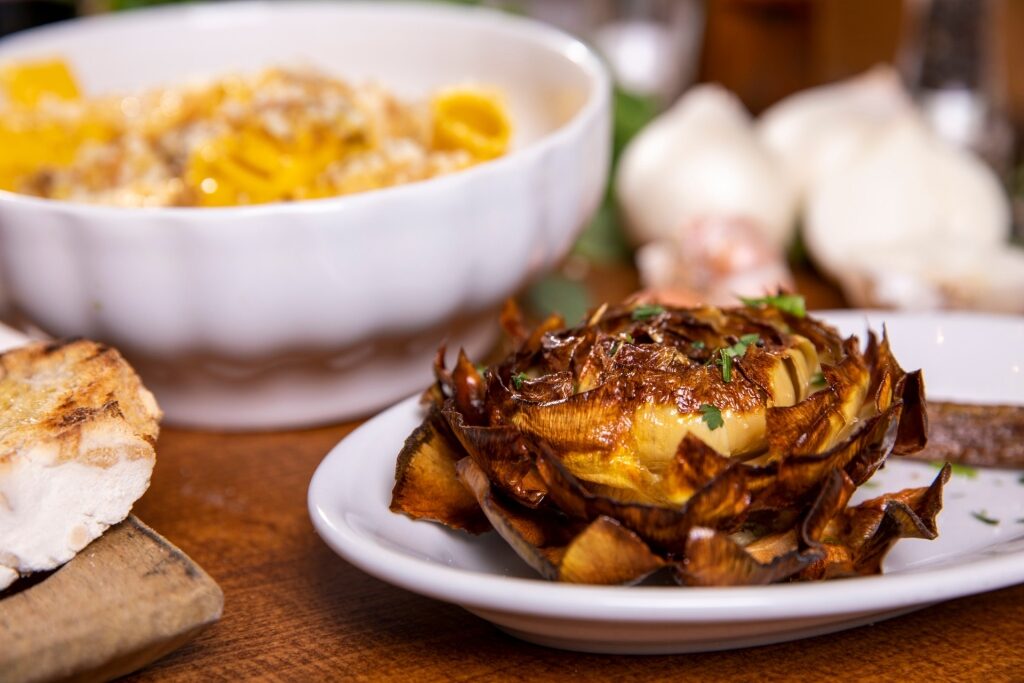
Carciofi alla giudia
The Jewish ghetto is tucked within the Sant’Angelo district. Once a place of great hardship for the Jews living within, it’s today an atmospheric Roman neighborhood that’s fine to explore. The Roman food that also emerged from this area is also worth close examination.
You’ll find the dish carciofi alla Giudia on menus throughout the year, but it’s in May, when the purple-tinted, smaller local variety of artichoke is in season that this dish is at its most lip-smackingly delicious.
This Renaissance-era preparation involves double-dipping the artichoke in oil and serving it up bronzed and crisped. The entire thing is eaten, the interior near-molten and luscious.
Pizza Romana

Pizza Romana
For those consumers of pizza who prefer to not eat the crust, Rome is your city. Pizza Romana is the hometown style—cracker thin, loaded with toppings, and crust-free.
Also known as “pizza bassa” or low pizza, to distinguish it from the inflated rims of the Neapolitans, the pizza romana was designed for eating on the go. It’s said to descend from the flatbreads of ancient Rome, devoured by workers on their way to their next lugging wine amphorae or temple construction appointment.
Modern pizza romana has a crisped-up texture thanks to the presence of olive oil in the dough mix. It can come round or by the rectangular slice—al taglio. It’s hard to walk a block without seeing some in a corner shop window.
For something a little special, grab a crisp pizza romana starter at Cesare al Casaletto on via del Casaletto, as your movement in a symphony of classics at this renowned trattoria.
Trippa Alla Romana

Trippa alla Romana
An emblematic comfort dish of the Testaccio district, trippa alla Romana translates as “Roman tripe”.
A fixture on traditional menus throughout Testaccio, its history is connected to the “Quinto Quarto”, a culinary legacy of the capital’s class system. The best cuts of meat would be taken by the rich and those in authority, and all the workers had to choose from was the “fifth fourth”.
In real terms, this meant the leftover cuts of offal such as the ox tail of coda alla vaccinare, another must-try of the Roman dishes. With trippa alla Romana, the tough tripe is slowly braised in a tomato and wine sauce until it’s meltingly tender. When served it’s accompanied by pecorino romano and shredded mint leaves, delivering a mouthful that’s hearty and fresh.
Maritozzo

Maritozzo
One of the Roman dishes that is often overlooked is a maritozzo, a traditional Roman sweet bun.
It’s available to pick up from bakeries throughout the Eternal City, or occasionally as a dessert option in restaurants. Most commonly enjoyed as a treat during Lent, maritozzi from the Middle Ages would have been sweetened with a blend of honey, raisins, and figs.
Today, the ingredients vary; even savory versions exist. But inside the lemon-fragranced brioche bun, you’ll typically find a well of sweet whipped cream. If you’re eating a maritozzo handed to you on March 1, be alert: the gift of one of these delicious buns signifies an imminent marriage proposal from the giver.
Read: Best Places to Go Shopping in Rome

Cafe in Rome
Discover the best Roman dishes—along with the city’s exquisite architecture, idiosyncratic neighborhoods, and towering artistic heritage on one of Celebrity’s cruises to Rome.



